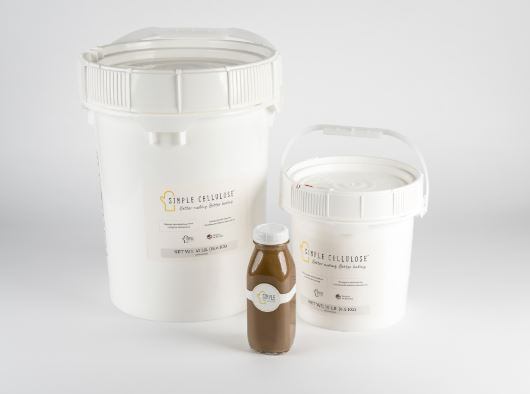The US company uses supercritical hydrolysis (see below) to extract cellulose from plant biomass using only water through its intellectual property-protected and trademarked Plantrose process.
The biomass is typically recovered from agricultural residual waste, such as sugar cane after processing.
“This is a very unique and new-to-the-world form of cellulose,” said Mike Hamilton, CEO of the company that is headquartered in a town called King of Prussia. “Traditional cellulose is very chemically modified while, thanks to the Plantrose process, our cellulose has only seen water. As a result, it’s a very clean material but also a unique form which gives it the bulk of its properties.”
'Native, natural and multifunctional'
The ingredient contains the natural stabiliser lignin, which means it performs well under high temperatures, and has several functions. It can optimise the uptake of fats and oils in a food matrix, act as a humectant to boost moisture and hold flavour and as an emulsifier in baked goods to replace eggs.
It can be used as a texturiser or thickener or as an extender in combination with more expensive hydrocolloids.
Renmatix was at IFT in Chicago last week focusing on bakery applications of simple cellulose but Hamilton said it could also be used for soups, sauces, meats and dairy, and non-food applications such as personal care products, paints or bioplastics.

“Anywhere cellulose is currently being used is in the realm of possibility for us. We are the next generation of plant matter, made only with water and more native and natural,“ he told FoodNavigator.
“The first reason to use simple cellulose is it supports the clean label movement, which is already a $180 billion (€154bn) industry. So if you, as a producer, are not satisfying demands for clean products, you’re missing an opportunity.”
There are a number of cellulose ingredients approved in Europe (E 460 to E 469) but they have ‘chemical-sounding’ names such as hydroxypropyl methyl cellulose or enzymatically hydrolysed carboxy methyl cellulose. Renmatix’s ingredient can be listed as simple cellulose in the US, and it expects this to be the case in Europe too.
“Secondly," Hamilton added, "it offers substantial cost savings through reduced cost-in-use. Baked goods use about $400 million (€342m) of liquid eggs in the US alone. We think we can replace up to 50% of their liquid egg purchases, and we’re showing this with the bakers we already work with.”
“There’s a business to support manufacturers’ growth in becoming more clean label and also how to become more efficient and boost margins.”
Renmatix sees the biggest short-term opportunities in egg replacement, allowing manufacturers to make a plant-based or vegan claim while making savings.
“Manufacturers are wrestling with liquid egg volatility at the minute. There are big recalls over salmonella scares and, if you look at a ten-year cycle, that happens at least three times every ten years. Eggs are highly volatile, it’s almost like the price of oil. If you’re a baker, that’s tough to manage.”
Europe on the horizon
With a Generally Recognised as Safe (GRAS) status secured earlier this year, Renmatix will be focusing on its domestic US market initially. So far, it has supplied local bakeries – “It’s a quicker route to market; it doesn’t require an eight-month approval process,” said Hamilton – but is now targeting larger, industrial bakers and manufacturers, and plans to take the necessary regulatory steps to secure EU approval in the future.
“We’re in a good spot right now with this first [GRAS] certification and we’re going to continue to invest and move this into Europe. All these efforts are in our near-view.”
Supercritical hydrolysis: ‘Giving water superpowers’
A water-based extraction process using high temperature and pressure whereby the water acts like a solvent to extract the cellulose without the use of acids, solvents or expensive enzymes.
Senior research scientist at Renmatix Danilo Cantero, PhD, explained: “If you keep the increasing temperature and pressure of water, the phase change between liquid and steam will disappear and both states become one. This is supercritical water, and at this stage its properties are completely different to what we know. Supercritical water and oil are completely soluble, for instance, and can mix.
“We take advantage of those properties to dissolve the cellulose in the plant matter, extract it from the matrix and then precipitate it to fine crystals. This process needs to be well controlled, otherwise it will fail.”
Controlling this reaction, where others fail, is Renmatix’s unique selling point, Cantero added.
Plantrose simple cellulose comes in a 15% gel form that, depending on the original plant material, ranges in colour from dark brown to light beige. Renmatix is currently manufacturing several hundred tonnes, which it says is enough to meet current demand.
It uses leftover agricultural residue, and has worked with sugar beets, sugar cane or oil palm residue. “A lot of this stuff ends up as waste but there is very valuable cellulose in there that we re-purpose,” he said.
Is it a water intensive process?
Hamilton did not say how much water the process uses but added the company is “mindful” of water use and tries to recycle or re-use where possible. It does not dry the biomass before processing it which means it can utilise the water contained in the plants.
In 2015, it won the US Environmental Protection Agency’s (EPA) Presidential Green Chemistry Challenge in the small business category for its Plantrose process. “[This shows] our credentials for the process and its sustainability were highly vetted by the EPA,” said Hamilton.
